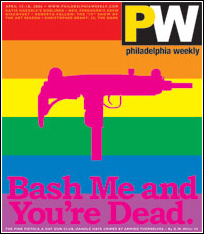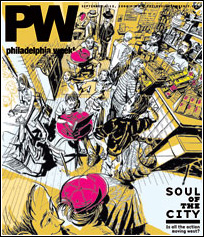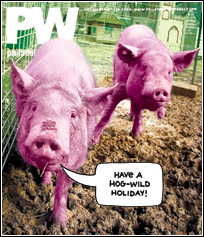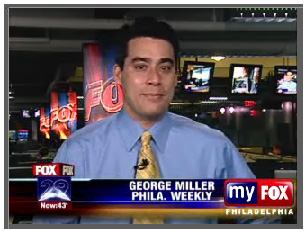Northern Exposure
Chinatown's expansion may merely serve as a bridge between cultures - or be its salvation.
From the July 22, 2009 Philadelphia Weekly.
When the Asian Arts Initiative (AAI) was evicted from the Gilbert Building in 2007, the nonprofit organization lost more than just a physical space.
For 10 years, young people of all races and ethnicities, from all over the city, were welcomed at the Chinatown location at 1315 Cherry Street. There, they mixed and mingled, learned about art and diversity, and were exposed to worlds that didn't exist in their neighborhoods. They also ran up the stairs to other arts organizations like Vox Populi, the Fabric Workshop and Highwire Gallery. They visited with artists who rented studio space in the 97-year-old building that was listed on the National Register of Historic Places.
It was a communal environment that inspired people to grow, experiment and create.
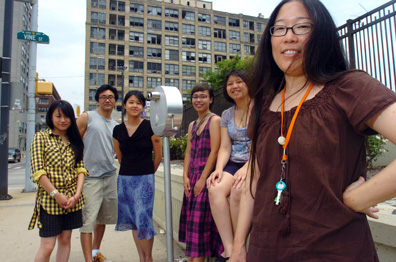
Then, the building was demolished, making room for the $700 million expansion of the Pennsylvania Convention Center.
The folks at AAI searched for another building where they and their fellow homeless arts groups could reside, preferably near their former location. But rents were high, especially in the densely packed Chinatown neighborhood.
"North was really the only direction to go," says Gayle Isa, AAI's executive director.
After a year in two temporary locations - one that had neither heat nor lighted bathrooms - AAI recently opened its new facility near 12th and Vine streets, on the edge of the former industrial wasteland that is now being promoted as Chinatown North.
"The concept of Chinatown North is catching on," says Isa.
***
It sounds like a developer's made-up moniker, like B3 (Blocks Below Broad) or JuNoGi (Just North of Girard). But Chinatown North is more than marketing hype. It may be the salvation of the ethnic enclave as barriers continue to constrict the historic neighborhood.
The proposed Foxwoods Casino at Eighth and Market is just the latest battle for the seemingly always-imperiled neighborhood.
In the past 40 years, Chinatown residents have witnessed the building of the Gallery and Gallery II, the Vine Street Expressway, the Convention Center and its in-progress 376,000-square-foot expansion. Each project ate into the neighborhood more and more.
"Why does Chinatown have to make all the sacrifices for the rest of Philadelphia?" asks John Chin, the executive director of the Philadelphia Chinatown Development Corporation (PCDC).
It could have been worse - Chinatown residents successfully fought off plans for a 750-bed federal prison, as well as a proposed Phillies stadium.
The neighborhood's location is a blessing and curse - being in the heart of Center City means vital foot traffic for local businesses. But the location also draws drooling developers who see a small voter base that historically has lacked political clout.
New things are happening, Chin says.
Chinatown business owners are moving back to the city from the 'burbs. Around 900 condo units were developed during the recent boom market, and many of the purchasers were Asian. Young people want to stay in the area where in years past, they fled. Waves of Asian immigrants have been arriving in Philadelphia, a much cheaper alternative to New York, reports Chin.
"They want to live in Chinatown," he adds. "They feel comfortable in Chinatown."
The neighborhood needs more space.
Tonight (July 22) at 6 p.m., PCDC and AAI will host a community forum at the Holy Redeemer Church (915 Vine St.) to discuss Chinatown's venture north.
***
"If we were sitting here 10 years ago, most people would say they didn't want to live on this side of Vine Street," says Chin.
The majority of the neighborhood's 4,000 residents lived within a few blocks of 913 Race Street, the site of the first Chinese business in Philadelphia, a laundry that opened in 1870.
The neighborhood grew quickly after the laundry opened, with around 700 Chinese residents by 1890. The area remained gritty well into the 1970s - home to the red light district, flophouses and bars on nearly
every corner.
"In spite of all this," Chin says, "Chinese immigrants were able to raise families here."
Plans to head north began in the 1990s. In 1997, PCDC built a 51-unit housing complex at Ninth and Callowhill streets, the site of the proposed federal prison. In 2004, the Delaware Valley Regional Planning Commission formalized the neighborhood's need to go north, championing 10th Street as the connector from old to new.
Already, Chinatown North has doubled in population to more than 1,000 residents, says Chin. But this is just the beginning.
"You can see there's no more room to expand on the other side [of Vine Street]," says Eugene Luong, the property manager at Lucky Gardens, a brand new residential/retail complex on 12th and Buttonwood streets. "Sooner or later, this is the only way to go."
***
"We think we can be an anchor for the redevelopment of Chinatown North," says Isa of AAI.
The organization has dreams of purchasing their new home in a 24,000-square-foot building. They'll rent out space to smaller arts organizations to replicate the communal feel they had at the Gilbert Building.
Unfortunately, their option to buy for $2.5 million expires in September and AAI doesn't know if they'll be able to find the money.
"I hope we can make this happen," Isa says. "Because we can be that bridge between cultures, and the bridge between Chinatown proper and the new area."



